
The Oklahoma City bombing was a domestic terrorist truck bombing of the Alfred P. Murrah Federal Building in Oklahoma City, Oklahoma, United States, on April 19, 1995. Perpetrated by American terrorists Timothy McVeigh and Terry Nichols, the bombing happened at 9:02 am and killed at least 168 people, including many children, injured more than 680 others, and destroyed more than one third of the building, which had to be demolished. The blast destroyed or damaged 324 other buildings within a 16-block radius, shattered glass in 258 nearby buildings, and destroyed or burned 86 cars, causing an estimated $652 million worth of damage. Local, state, federal, and worldwide agencies engaged in extensive rescue efforts in the wake of the bombing. They and the city received substantial donations from across the country. The Federal Emergency Management Agency (FEMA) activated 11 of its Urban Search and Rescue Task Forces, consisting of 665 rescue workers who assisted in rescue and recovery operations. Until the September 11 attacks in 2001, the Oklahoma City bombing was the deadliest terrorist attack in the history of the United States. It remains the deadliest act of domestic terrorism in U.S. history.
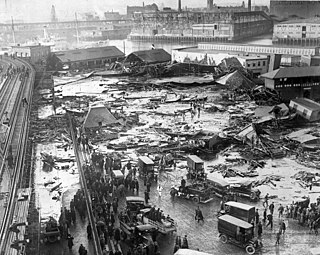
The Great Molasses Flood, also known as the Boston Molasses Disaster or the Great Boston Molasses Flood, occurred on January 15, 1919, in the North End neighborhood of Boston, Massachusetts. A large storage tank filled with 2.3 million US gal (8,700 m3) weighing approximately 13,000 short tons (12,000 t) of molasses burst, and the resultant wave of molasses rushed through the streets at an estimated 35 mph (56 km/h), killing 21 and injuring 150. The event entered local folklore and residents claimed for decades afterwards that the area still smelled of molasses on hot summer days.

Ninnekah is a town in Grady County, Oklahoma, United States. The population was 1,002 at the 2010 census.

Duncan is a city and county seat of Stephens County, Oklahoma, United States. The population was 23,431 at the 2010 census. Its main claim to fame is as the birthplace of the Halliburton Corporation. Erle P. Halliburton established the New Method Oil Well Cementing Company in 1919. Halliburton maintains seven different complexes in Duncan plus an employee recreational park, but the corporate offices relocated first to Dallas and later to Houston.
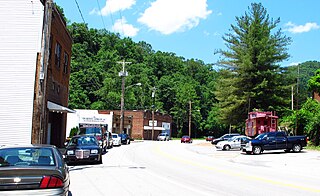
Kimball is a town in McDowell County, West Virginia, United States. The population was 194 at the 2010 census.
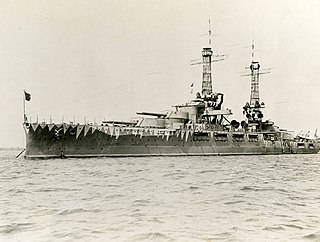
USS Oklahoma (BB-37) was a Nevada-class battleship built by the New York Shipbuilding Corporation for the United States Navy, notable for being the first American class of oil-burning dreadnoughts.
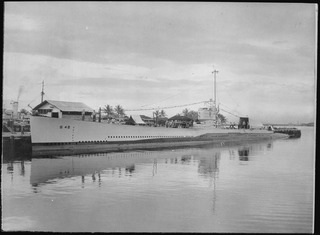
USS S-4 (SS-109) was an S-class submarine of the United States Navy. In 1927, she was sunk by being accidentally rammed by a Coast Guard destroyer with the loss of all hands but was raised and restored to service until stricken in 1936.

On July 17, 1981, two walkways collapsed at the Hyatt Regency Kansas City hotel in Kansas City, Missouri, United States, one directly above the other. They crashed onto a tea dance being held in the hotel's lobby, killing 114 and injuring 216. As a product of a corporate culture of profound neglect, the disaster contributed many lessons to the study of engineering ethics and errors, and to emergency management. The event remains the deadliest non‑deliberate structural failure in American history, and it was the deadliest structural collapse in the U.S. until the collapse of the World Trade Center towers 20 years later.

The Mormon handcart pioneers were participants in the migration of members of The Church of Jesus Christ of Latter-day Saints to Salt Lake City, Utah, who used handcarts to transport their belongings. The Mormon handcart movement began in 1856 and continued until 1860.

SS Valencia was an iron-hulled passenger steamer built for the Red D Line for service between Venezuela and New York City. She was built in 1882 by William Cramp and Sons, one year after the construction of her sister ship Caracas. She was a 1,598 ton vessel, 252 feet (77 m) in length. In 1897, Valencia was deliberately attacked by the Spanish cruiser Reina Mercedes off Guantanamo Bay, Cuba. The next year, she became a coastal passenger liner on the U.S. West Coast and served periodically in the Spanish–American War as a troopship to the Philippines. Valencia was wrecked off Cape Beale, which is near Clo-oose, on the west coast of Vancouver Island, British Columbia, on 22 January 1906. Since her sinking killed 100 people, some classify the wreck of Valencia as the worst maritime disaster in the "Graveyard of the Pacific", a famously treacherous area off the southwest coast of Vancouver Island.
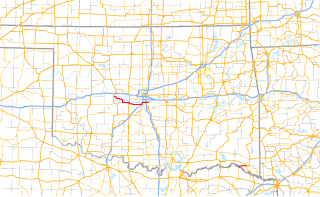
State Highway 37 is a designation for two separate highways in the state of Oklahoma. The northern section runs between Hinton and Moore in central Oklahoma, while the southern section runs from the Texas state line at the Red River to Idabel, in southeastern Oklahoma. The northern section of SH-37 runs 65.8 miles (105.9 km) from US-281 in Hinton to Sunnylane Road in Moore. The southern section of SH-37 is 12.54 miles (20.18 km) long.

The Lofthouse Colliery disaster was a mining accident which took place in the West Riding of Yorkshire, England on Wednesday 21 March 1973, in which seven mine workers died when workings were flooded.
The SS Tregenna was a steamship built by Wm. Gray and Company Ltd. for Edward Hain & Son of St Ives, Cornwall, United Kingdom. Originally named the War Bulldog, she was renamed before completion in 1919.

The Nathan F. Cobb was a three-masted schooner named after the shipbuilder and founder of Cobb's Salvaging Company whose many rescues of stranded ships help lead to the formation of the United States Life-Saving Service. Despite its namesake's history of shipwreck rescues, the Nathan F. Cobb capsized in heavy seas on 1 December 1896 en route from Brunswick, Georgia to New York with a cargo of timber and cross ties. The cook and a shipmate drowned when they were swept overboard in violent seas. The crew righted the vessel by removing the three masts and they drifted for four days until they became grounded on a sandbar off Ormond Beach, Florida. Rescue attempts led to the drowning of volunteer Fred Waterhouse, whose body was never recovered, but no other crew members were lost. A plaque commemorates Fred Waterhouse's rescue efforts. The Cobb Cottage, a structure built using materials salvaged from the ship, is part of Ormond Beach's Historic Trail.
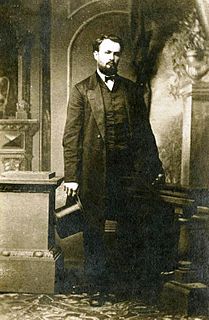
David Patten Kimball was an early Mormon leader, one of the three young men of the Sweetwater handcart rescue.

The 1957 Aquila Airways Solent crash occurred on the Isle of Wight in England on 15 November. With 45 lives lost, at the time it was the second worst aircraft accident within the United Kingdom, then at the time the worst ever air disaster to occur on English soil.
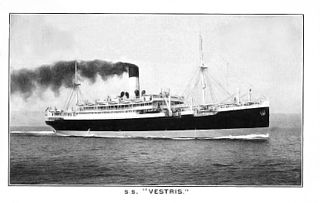
SS Vestris was a 1912 steam ocean liner operated by Lamport and Holt Line and used on its service between New York and the River Plate. On 12 November 1928 she began listing about 200 miles (300 km) off Hampton Roads, Virginia, was abandoned, and sank, killing more than 100 people. Her wreck is thought to lie some 1.2 miles (2 km) beneath the North Atlantic.

The 1929 Imperial Airways Handley Page W.10 crash happened on 17 June 1929 when Handley Page W.10 G-EBMT suffered an engine failure and subsequently ditched in the English Channel off Dungeness with the loss of seven lives. The aircraft was operating an international scheduled flight from Croydon to Le Bourget Airport, Paris, France.
The Cadeby Main Pit Disaster was a coal mining accident on 9 July 1912 at Cadeby Main Colliery at Cadeby, at Doncaster, now in South Yorkshire, England, killing 87 men. Early in the morning of 9 July 1912 an explosion in the south-west part of the Cadeby Main pit killed 35 men with 3 more dying later due to their injuries. Later in the same day after a rescue party was sent below ground another explosion took place killing 53 men of the rescue party.

Cowlitz was a shallow-draft sternwheeler built for service on the Cowlitz River in southwestern Washington State. The vessel also served on the Columbia River. Cowlitz was in service from 1917 until September 1931, when, not far from The Dalles, Oregon, it sank in the Columbia river in a storm.

















